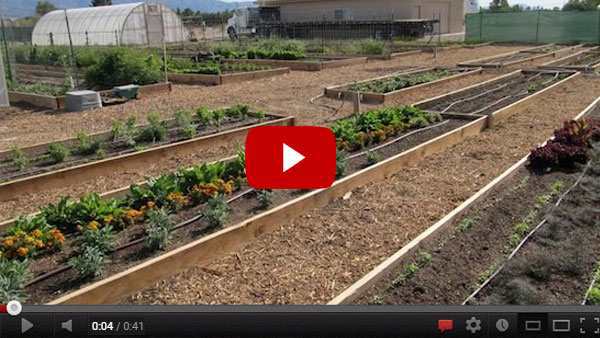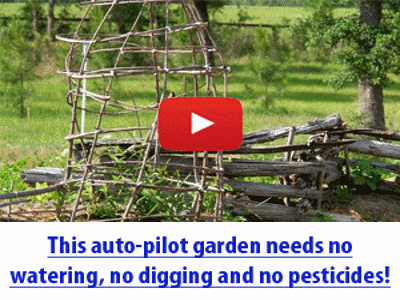Straw Bale Gardening Mushrooms and Potatoes
I should start off by saying that I have had a vegetable garden for a few years. The soil is poor, it is constantly full of weeds and my sprinkler system is on the fritz. I finally made the decision to try the straw bale garden because if nothing else, I would compost a bunch of organic material and could till it into the ground next spring.
Get cheap bales. They aren’t that expensive. If you don’t have bales, you can make your own out of organic material. I will have some notes below on how to do that. And also, just make sure that you set them up so there is plenty of airflow. You also, don’t forget that we have a lot of vines that are going to take up a lot of space too. So these plants are going to get bigger. So really make sure you give yourself enough space.
Alright, a couple more things about picking out your bales and setting them up. Make sure you get straw bales, not hay bales. Hay bales of lots of seed. You get them wet and those seeds will grow and you are going to have a great big weedy mess. Get straw bales, um, they are just left over from grains farmers have. They are all over the place. Um, if you have … when they make them, they cut one side. So there is a cut side. You can see here this is what it looks like. And you can see each of these holes in here. It looks like a straw. That is why it is called a straw bale. Ok? This one we put sideways to see what the difference would be. This is the side. You don’t want this side up. You want the straw side up. Because it is going to suck up the moisture better um, and hold the fertilizer and things in there better so it is going to decompose faster and you are going to get a lot more happy with it. But umm, we will follow this and we will see what happens.
Originally appeared : livedan330.com
Straw Bale Gardening Mushrooms in your bale
This post is about straw bale gardening mushrooms showing up in your bale.
Straw Bale Gardening is becoming more and more popular. A new type of gardening often leads to a whole new set of questions and concerns for the gardener. One we hear quite often is concerning mushrooms in your bale after the weather warms up and the bale has been conditioned.
Good news. We happen to live a couple of miles from an expert on straw bale gardening. Let’s make that THE expert on Straw Bale Gardening, Joel Karsten of Strawbalegardens.com. Joel is the author of Straw Bale Gardens, a New York Times bestseller. We are collaborating with Joel to do a whole series on straw bale gardening this summer and fall.
We stopped by Joel’s house yesterday to check out his gardens. The pictures you see are from Joel’s own gardens. Joel is a wealth of information and as nice a guy as you will ever meet. Here is what Joel has to say about mushrooms in your straw bales:
Mushrooms-
Everything that has ever been alive eventually decomposes and becomes soil. Mother nature’s tool box of “decomposers” includes: Insects, worms, bacteria, mold and FUNGI (mushrooms). As a bale of straw, which is essentially a solid mass of tightly squeezed stalks, is watered, fertilized and begins to decompose, any spores of fungi that happen to be present or introduced by the wind, tend to sprout. Fed by the newly released carbon contained in the cells of the plants which are breaking down, the mushrooms often thrive. Most varieties of fungi that bloom and grow on straw bales are not long lived, dying off within 24 hours. The mushrooms you get tomorrow, are probably brand new from spores which sprouted the night before. The vast majority are harmless, however I never recommend eating any of the mushrooms that grow naturally, unless you first test them on someone you don’t like. Your plants will be unaffected by these mushrooms, so think of the mushrooms in your Straw Bale Garden as a compliment from mother nature. She is telling you that you have done a good job of preparing that bale for the newly planted transplants or seedlings that you will be growing. If a big mushroom is pushing your tiny seedlings out of the bale, then you may need to squish down that mushroom a bit, but otherwise just try to ignore them. If you try to brush them off or squirt them off with your hose, they will grow right back, sometimes in just hours. All in all, mushrooms are a great sign that you have prepared the bales correctly, so do your best to simply ignore them in your Straw Bale Garden.
Find out how more than 78,000 Americans have greatly benefited from this amazing creation, and found energy independence, Click Here!
Potatoes –
It’s EASY to grow stuff in straw bales. I planted a piece of a potato into a straw bale, right on top of concrete (where I had no soil, no soil container, etc), and sure enough the spuds grew fine. They should be ready to harvest in a few weeks. It will be super EASY to harvest, since I won’t even need to “dig” for the spuds, just use my hand to pull them out of the straw… what could be easier?
Potato harvest from bales is easy, with no fork or shovel, simply cut the strings and kick over the bales, and pick up the potatoes. No marks on the potatoes from the forks or shovels, so they will store well, unblemished. Wrap them in brown paper, this helps them store longer. Keep them in a dry cool place, and check your stock often, tossing out any that have gotten soft or begun to rot. You’ll have delicious potatoes until the following summer when new stock will be ready again.
In normal soil gardens it is important to hill up the soil around the stem as the potato emerges. This is important because potatoes form on on the stem not on the roots. If planted too deep in the soil, the stem has a hard time emerging, because it cannot push up more than a few inches of soil. In a straw bale, we simply plant the potato cutting deep into the bale. While a bale may be 20″ high, we will plant 16-18″ deep in a “crack” in the bale. The looseness of the bale will allow the stem to easily reach the surface, and the potatoes will form along this stretch of stem, filling the bale with potatoes. I suggest two or three potatoes in a bale, even while planting other crops on the surface of the bale. These “surface” plantings will be harvested early before the potato vine has stretched its way above and around the bale. Wait for the vine to flower and this is the earliest the potatoes will be ready, however waiting for the vine to wither later in the fall will allow the potatoes inside to mature a bit longer.
Try Straw Bale Gardening, especially if you like potatoes, you’ll never go back to growing potatoes in the soil. Growing potatoes any other way will seem silly once you’ve done it this way.
Here is an overview of the project.
Time: 4 hours with 2 people to install the raised bed and about the same to harvest it and clean the spuds. Throughout the summer there was about 2 hours total spent putting more straw on top as the old straw compressed.
In vs Out:
We put in 30ish pounds of potatoes and got back around 250. I would do things differently in the future. The potatoes required at the outset could be severely reduced by cutting them up before planting. I would also space the potatoes out more as some of them appeared to be competing for nutrients.
Our grandfathers had more knowledge than any of us today and thrived even when modern conveniences were not available. They were able to produce and store their food for long periods of time. The Lost Ways is the most comprehensive book available. All the knowledge our grandfathers had, in one place.Here’s just a glimpse of what you’ll find in the book:
Table Of Contents:
Making Your Own Beverages: Beer to Stronger Stuff
Ginger Beer: Making Soda the Old Fashioned Way
How North American Indians and Early Pioneers Made Pemmican
Wild West Guns for SHTF and a Guide to Rolling Your Own Ammo
How Our Forefathers Built Their Sawmills, Grain Mills,and Stamping Mills
How Our Ancestors Made Herbal Poultice to Heal Their Wounds
What Our Ancestors Were Foraging For? or How to Wildcraft Your Table
How North California Native Americans Built Their Semi-subterranean Roundhouses
Our Ancestors’Guide to Root Cellars
Good Old Fashioned Cooking on an Open Flame
Learning from Our Ancestors How to Preserve Water
Learning from Our Ancestors How to Take Care of Our Hygiene When There Isn’t Anything to Buy
How and Why I Prefer to Make Soap with Modern Ingredients
Temporarily Installing a Wood-Burning Stove during Emergencies
Making Traditional and Survival Bark Bread…….
Trapping in Winter for Beaver and Muskrat Just like Our Forefathers Did
How to Make a Smokehouse and Smoke Fish
Survival Lessons From The Donner Party
Get your paperback copy HERE
Books can be your best pre-collapse investment.
The Lost Ways (Learn the long forgotten secrets that helped our forefathers survive famines,wars,economic crisis and anything else life threw at them)
Survival MD (Best Post Collapse First Aid Survival Guide Ever)
Conquering the coming collapse (Financial advice and preparedness )
Liberty Generator (Build and make your own energy source)
Backyard Liberty (Easy and cheap DIY Aquaponic system to grow your organic and living food bank)
Bullet Proof Home (A Prepper’s Guide in Safeguarding a Home )
Family Self Defense (Best Self Defense Strategies For You And Your Family)
Survive Any Crisis (Best Items To Hoard For A Long Term Crisis)
Survive The End Days (Biggest Cover Up Of Our President)
Drought USA (Discover The Amazing Device That Turns Air Into Water)



